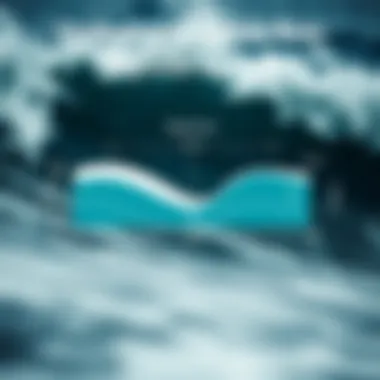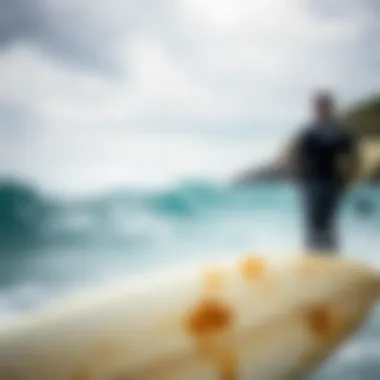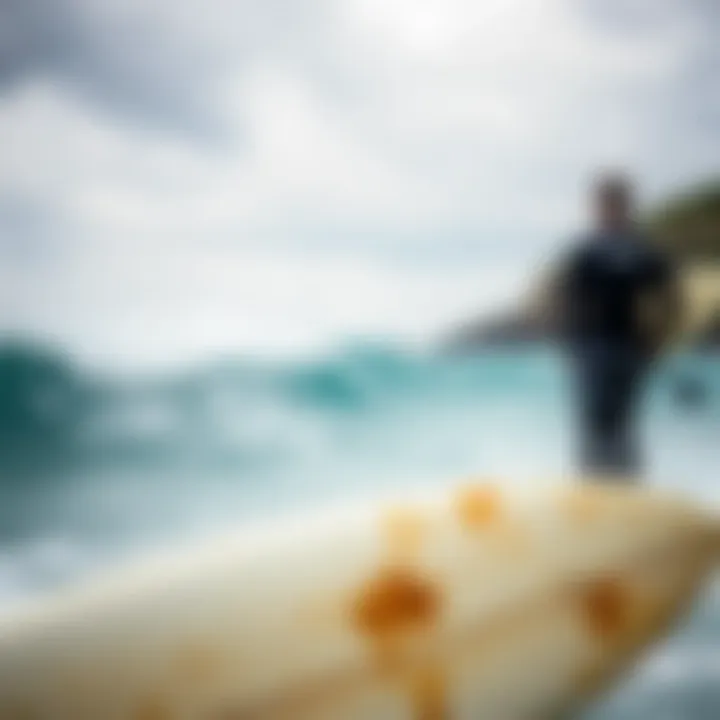Understanding Riptide Warnings: Essential Safety Tips


Intro
Every year, large crowds are drawn to the beach, seeking the thrill of surfing and the beauty of ocean waves. Yet, beneath the surface of this picturesque scene, riptides lurk, posing serious risks if not understood correctly. Riptides are swift currents that can sweep even the most experienced swimmers out to sea in a matter of moments. Knowing about riptide warnings is not just a precaution; it’s an essential component of beach safety.
In this article, we will guide readers through the intricacies of riptides and their warnings. By dissecting their nature, considering protective measures, and underscoring the significance of being aware of local conditions, we aim to arm surfers and beachgoers alike with foundational knowledge necessary for safety.
Understanding riptides is not merely an academic exercise; for many, it can be a matter of life or death. It’s about making informed decisions at the beach that can mitigate risks and enhance enjoyment. Whether you are a casual beachgoer, an experienced surfer, or an instructor, you have a role to play in ensuring safety not only for yourself but for others around you. Let’s embark on this journey to amplify awareness and preparedness related to riptides.
Prologue to Riptides
Riptides, often referred to as rip currents, pose a significant threat to beachgoers and especially surfers. Understanding riptides is essential for anyone who ventures into ocean waters. Not only do riptides lead to dangerous situations, they can also cause panic and confusion among those caught in their grasp. Grasping the nuances of these currents can mean the difference between a harrowing experience and a safe day at the beach.
Definition and Characteristics
Riptides are narrow channels of fast-moving water that flow away from the shore. These currents can be deceptively strong and are formed primarily by the interaction of waves and currents. When waves break near the shore, they push water onto the beach. The water must then return to the ocean, and it does this by finding the path of least resistance, often creating a powerful return current.
What sets riptides apart from regular waves is their velocity; they can reach speeds of over 8 feet per second, enough to sweep even the strongest swimmer off their feet. Typically, a riptide can be identified by:
- Differences in water color: Areas where the water appears darker often signal deeper channels of water flowing away from the shore.
- Wave patterns: Uneven wave formations or sudden gaps in the waves can indicate a riptide.
- Foam and debris moving seaward: If you see foam or leaves moving outwards, it's a likely sign of a riptide in action.
The Science Behind Riptides
To fully appreciate riptides, understanding the scientific principles involved is crucial. Riptides are essentially surface currents caused by the gravitational forces exerted by the moon and sun, coupled with the effects of coastal geography. The wind also plays a vital role, as it creates surface waves; stronger winds often lead to more vigorous riptides.
Among the various types of riptides, there are some that are more commonly seen:
- Permanent riptides: These occur at certain locations regularly, and their patterns can typically be anticipated based on tides and weather.
- Transient riptides: These arise unexpectedly due to changing offshore wave conditions, making them unpredictable.
Awareness of riptides is further underscored by statistics. According to the United States Lifesaving Association, riptides are responsible for the majority of beach rescues, emphasizing the need for education on this vital topic.
By comprehending what riptides are and how they form, surfers and beachgoers can better prepare themselves, react appropriately, and make informed decisions when they’re enjoying the ocean. Recognizing these currents can mitigate risks and lead to safer ocean experiences.
Local Riptide Warnings
Local riptide warnings play a fundamental role in ensuring safety along coastal areas, especially for surfers and beach enthusiasts. The importance cannot be overstated; understanding these warnings can often be the difference between a safe day of surf and a serious accident. Riptides are powerful and unpredictable, making it vital for beachgoers to stay informed about local conditions. Knowledge of riptide risks can help individuals plan their activities more effectively and take proactive measures to protect themselves while enjoying the ocean.
Interpreting Local Signage
Every beach has its own unique set of signage that communicates crucial information regarding riptide conditions. Recognizing these signs is like having a lifebuoy thrown to you in a storm. They typically indicate current conditions, including warnings or advisories related to riptide presence. This signage can be as detailed as a weather report or as concise as a simple flag system, and it can be found at entrance points and along pedestrian paths leading to the water.
It’s important to pay attention to the language used; phrases like "dangerous currents" or "swim at your own risk" can signify the presence of a riptide. This local knowledge isn’t just academic; it can have tangible benefits. Knowing how to interpret these signs helps visitors avoid undesirable situations and create an environment focused on safety. Just like choosing a good wave to ride, understanding the meaning behind local warnings shapes your overall beach experience.
Understanding Flag Systems
Flag systems are a universal method of alerting beachgoers to current water conditions, including the threat of riptides. Each color symbolizes a particular level of risk — from the reassuring green, indicating safe conditions, to the concerning red, signifying dangerous waters. These flags act as quick visual cues, enabling surfers and swimmers to gauge their environment at a glance.
"A single glance at a flag can save a life. Always check the flag status before entering the water!"
For example, a yellow flag usually suggests caution, indicating that riptides may be present, but not necessarily at a dangerous level. Red flags, on the other hand, are a clear indication to steer clear of the water altogether. Understanding this system helps in maintaining vigilance; it empowers individuals to make informed decisions based on the flag status. Whether you’re a seasoned surfer or a casual beachgoer, being aware of the flag system is a step towards ensuring both your safety and enjoyment while in the water.
In summary, local riptide warnings—from signage to flag systems—are essential tools for anyone heading to the beach. They facilitate a deeper understanding of the ocean’s unpredictable nature, providing critical information that enables beach visitors to navigate safely. Awareness and education surrounding these elements contribute directly to minimizing risks associated with riptides.
Identifying Riptide Conditions
Understanding how to identify riptide conditions is vital for anyone heading to the beach. Riptides can be deceptively powerful and can catch even the most experienced swimmers and surfers off guard. Knowing what to look for helps in increasing awareness and ensuring personal safety. This section delves into the key visual signs of riptides and how water color variations can indicate potentially dangerous currents.


Visual Signs of Riptides
When facing the ocean, keen observation is your best ally. Many people might miss the subtle indicators suggesting riptide presence. Here are crucial visual signs to watch out for:
- Breaks in Wave Patterns: Observing where waves consistently break can help. If you see a narrow channel where waves don't break or seem quieter, that may indicate the presence of a riptide.
- Foam and Debris Movement: Keep an eye on how foam, seaweed, or other debris move across the water surface. In a riptide, these items tend to move seaward, creating a noticeable stream.
- Water Color Differences: Often, the water may display distinct color changes. Shallow waters typically look more vibrant, while riptide areas can appear darker due to deeper channels.
These signs aren’t always apparent, especially to the untrained eye. Hence, taking the time to familiarize oneself with the surroundings can make a significant difference in identifying any concerning riptide conditions.
Water Color Variations
Water color may not seem like a crucial safety factor, but it can reveal a lot about the underwater environment and current conditions. Variations in color can indicate depth differences, which are significant when assessing the risk of riptides:
- Blue and Green Tones: These are common in areas with clear water and less sediment. If the water appears bright blue or green, it generally indicates a safe place to swim.
- Brownish or Murky Water: Areas where the water looks muddy or brown often signify shallower regions, mixed up sand, or sediment. However, if this coloration is seen near the shore while waves are moving outward, it could indicate a riptide, as sediment is being dragged away from the beach.
Observing these aspects can be vital. Beachgoers and surfers should train their eyes to catch these subtle cues before heading into the water. Being aware of your surroundings serves as the first line of defense against the hazards posed by riptides.
Remember, not all bodies of water are the same. Personal caution and thorough observation can save lives.
For more detailed information about riptides and safety tips, visit the United States Lifeguard Association at usla.org.
Safety Measures During Riptide Conditions
Understanding safety measures during riptide situations is vital for anyone planning to spend time at the beach. Riptides can be treacherous, and being prepared can make all the difference. Many think that swimming skills alone will suffice in handling riptide encounters, but experience shows that it’s not just about how well you can swim. Knowing the right practices can greatly reduce risk and enhance safety.
Precautionary Practices for Surfers
Surfers are often among the first to be aware of riptide conditions; however, they can also be the most vulnerable. Here are some precautionary practices for surfers that can bolster their safety:
- Check the Forecast: Before hitting the waves, always check local surf conditions, possibly from the National Weather Service or the surf-report websites like Surfline. Knowing if riptides are a concern that day allows for informed decision-making.
- Buddy System: Surfing with a partner not only provides companionship but also adds an extra layer of safety. If things go south, a buddy can help or summon help.
- Awareness of Surroundings: Always be conscious of the water conditions. Observe waves, currents, and consult other surfers as they might have real-time insights. If things look wild, it might be best to hold off on surfing.
- Know Your Limits: Not every day is a good day for surfing. Waves might be a bit too aggressive for your skill level. Opt for days where conditions align with your experience.
- Warm-Up: It may seem simple, but stretching before entering the water prepares your body and reduces fatigue. Tired muscles can lead to hasty decisions.
In tumultuous surf, a seasoned surfer must adapt swiftly. Riptides are sneaky, and keeping these practices in mind can lead to a significantly safer experience.
Educating the Beach Community
A well-informed beach community is pivotal for riptide safety. Engaging locals, beachgoers, and even tourists in dialogue can help foster a culture of awareness. Here’s how education can shape safer beach environments:
- Workshops and Training Sessions: Local surf schools or community centers can host workshops that impart knowledge on riptides. Teaching residents and visitors about identifying risky conditions is a step towards community preparedness.
- Flyers and Informational Boards: Simple, visual aids placed at strategic points on the beach can impart quick information about riptides. Images showing signs of riptide and simple do's and don'ts can stick in people’s minds.
- Social Media Campaigns: Engaging content on platforms like Facebook or Instagram can reach a broad audience. Posting educational snippets or videos on riptide safety allows for an easy sharing method among the community.
- Lifeguard Initiatives: Lifeguards play a crucial role in education. They can have informal talks with beachgoers, explaining current conditions or reinforcing the importance of safety when swimming.
Being proactive is key. An informed public reduces incidents and cultivates a sense of community responsibility toward safety.
In summation, understanding safety measures during riptide conditions requires a collective effort. Surfers must implement specific practices, while the broader beach community must engage in educational initiatives to create a safer environment for everyone.
What to Do If Caught in a Riptide
When the forces of nature conspire to pull you away from safety, understanding what to do can very well be the diffrence between life and death. Riptides are unpredictable, and panic can cloud judgment. That's why knowing how to react when caught in one is not just useful; it's essential. Here, we will outline the key strategies to adopt, ensuring that you remain calm and composed amid the chaos of swirling waters.
Staying Calm and Assessing the Situation
Begin by quickly assessing your situation:
- Direction of Current: Notice how the water is moving. Riptides usually flow away from shore, creating channels of turbulent water.
- Proximation to Land: Are you still within visible distance of the beach? Is there land nearby where you could swim?
- Strength of Current: If you notice that the waves are breaking around you beginning to lessen, it might indicate the riptide isn’t as strong in that particular stretch.
Recognizing these factors gives you a clearer picture of your predicament. It’s crucial to distinguish between fear and reality; often, the first instinct is to fight the current. Yet, that instinct can lead to exhaustion.
"Staying cool under pressure helps you make better choices. Panic can lead to dangerous mistakes."


Strategies for Escape
Once you've steadied your nerves and gathered vital information, it's time to formulate your escape plan. Here are some tried-and-true methods:
- Swim Parallel to the Shore: If you find yourself stuck in a riptide, the first rule is to swim parallel to the beach rather than straight back. This allows you to escape the narrow current that pulls out, enabling you to swim back at an angle.
- Float and Conserve Energy: If at any point you feel fatigue setting in, take a moment to float on your back and catch your breath. This is also a chance for you to get a lay of the land, spotting if any nearby surfers or boats may be able to assist you.
- Signal for Help: If you're really caught, making yourself visible is key. Wave your arms above your head or yell to attract attention. Lifeguards or nearby surfers can often reach you faster than you can reach the shore.
- Follow the Current When Necessary: Sometimes, the current might be too strong to fight. In such cases, allowing it to take you until it weakens might be necessary before you start your swim back to land.
Employing these strategies as soon as you're in a sticky situation can greatly improve your chances of getting out unscathed. The ocean can be a fickle partner, but with the right mindset and approach, you can reclaim your safety and confidence.
Community Initiatives and Education
The significance of community initiatives and education in understanding riptide warnings cannot be overstated. Local communities play a crucial role in enhancing public awareness about ocean safety, especially regarding riptides. When residents and local authorities collaborate on initiatives that focus on educating beachgoers, the risks associated with riptides can be significantly minimized.
Benefits of Community Initiatives
- Informed Public: Such programs empower the public with knowledge about recognizing riptide signs, which increases overall awareness and preparedness.
- Stronger Community Bonds: Engaging in collective learning experiences reinforces community ties, fostering a sense of responsibility amongst members to look out for each other.
- Resource Optimization: Local governments can better allocate resources to hotspots, ensuring that safety measures are prioritized based on community needs.
However, for these initiatives to succeed, several considerations must be kept in mind. It is essential to tailor programs to address the unique challenges and demographics of each beach community. Educational content must be accessible and relatable to all ages, using clear language without overwhelming technical jargon. By doing this, the community can build a knowledgeable and vigilant populous against the dangers posed by riptides.
Local Workshops and Training
Local workshops offer hands-on opportunities for beachgoers to learn about riptide safety firsthand. These sessions can cover various topics, from understanding the science behind riptides to practical safety measures. They can also include demonstrations on how to react in riptide situations.
Workshops should be interactive and engaging, incorporating activities that help reinforce the learning experience. For example, using simulations to recreate riptide conditions allows participants to visualize how these powerful currents function. This sort of continuous education is critical in maintaining awareness, particularly among younger community members who may be more inclined to take risks in the water.
Partnerships with Lifeguards
Building partnerships with lifeguards adds yet another layer of protection. Lifeguards serve as the frontline defenders of beach safety, and their insights into local riptide conditions are invaluable. Collaborations between local governments, surf clubs, and lifeguard organizations can lead to the development of tailored safety programs.
For instance, lifeguards can offer regular updates on tide patterns and potential riptide threats through workshops or dedicated social media channels, ensuring the community is always informed. Lifeguards can work with schools and community centers to provide training that covers how to respond to a riptide situation, which could save lives.
Moreover, engaging lifeguards in community forums allows for direct feedback from those who witness potential dangers firsthand. This two-way street can lead to the development of better warning systems and protocols for surf rescue operations.
"An informed surfer is a safe surfer. Direct engagement enhances knowledge, leading to reduced risks for everyone at the beach."
By integrating local workshops and lifeguard partnerships into community initiatives, educational programs can effectively enhance understanding and awareness of riptides, reducing risks and fostering safer beach environments.
Comparison of Riptide Risks at Different Beaches
Understanding the comparison of riptide risks across various beaches is crucial for anyone who spends time in coastal waters. Each beach presents unique features that affect how riptides form, their intensity, and how often they occur. For surfers, instructors, and even casual beachgoers, recognizing these differences can mean the difference between a fun day on the water and a dangerous situation.
Riptide Patterns in Coastal Regions
Riptide patterns can differ significantly from one coastal area to another. It’s not just about tides, but also how coastal structures, ocean floor composition, and geography play roles.
For example:
- Narrow beaches with steep drops: These often create stronger riptides, especially during peak tide changes. A narrow space can funnel water, increasing current strength.
- Wide, flat beaches: Generally, they might see weaker riptide conditions, although sandbars can form which may create unpredictable currents.
- Estuary proximity: Beaches near river mouths may experience complex riptide patterns due to the influence of both freshwater outflows and ocean currents.
Understanding these distinct patterns can assist surfers in knowing when it's best to hit the waves or take a step back.
Variances in Tide and Wind Conditions
The conditions of tides and wind can heavily influence the formation of riptides. Regularly checking tide schedules and local forecasts is paramount when planning a beach day.
- High Tides vs. Low Tides: During high tide, waves can break more aggressively, potentially creating riptides as water rushes back out to sea. Traditional wisdom often suggests that low tide can be safer for swimming, although one should remain vigilant, as it depends on the beach’s specific characteristics.
- Wind Conditions: Strong winds can impact wave heights and, consequently, the strength of riptides. Because wind patterns can change, it’s advantageous to acquire real-time weather updates before heading to the beach.
- Seasonal Changes: Many coastal regions experience shifts in tide and wind patterns based on seasonal changes, which can vary by region. Familiarizing oneself with these changes can significantly reduce the risks associated with riptides.


"Being aware of local conditions and how they change can protect you and your loved ones from unexpected riptide dangers."
By recognizing the variances in riptide risks at different beaches, coastal enthusiasts can better prepare themselves, ensuring a safer experience. The more knowledge one has about the environment, the better equipped they are to navigate it.
Riptides and Environmental Impacts
Understanding the interplay between riptides and environmental factors is crucial not just for the safety of beachgoers and surfers, but also for appreciating the delicate balance of coastal ecosystems. Riptides, often viewed merely as dangerous currents, are a natural phenomenon that serve broader ecological functions. By fathoming their relationship with environmental changes, we can develop better strategies for both safety and conservation.
Influence of Climate Change
Climate change is a game changer in how we perceive and experience natural phenomena, including riptides. Observed patterns show that increasing sea temperatures and melting polar ice are altering ocean dynamics significantly. Specifically, as sea levels rise, the scope and strength of riptides may also shift.
- Intensified Storm Patterns: More intense storms can create conditions for stronger riptides. The punky winds that howled down from the stormy skies can whip up waves that, when they crash onto the shore, have a greater chance of pulling unsuspecting swimmers into dangerous currents.
- Temperature-Driven Changes: Warmer ocean temperatures are leading to modifications in local weather patterns, affecting how riptides form. A beach that might have been relatively safe a few years ago might become a hazard because of these changes in wave action and wind patterns.
- Increased Erosion: As coastlines erode due to rising seas and stronger riptides, the geography of beaches themselves is changing. This can create new channels for riptides to form, often where they weren’t present before.
It's easy to overlook how climate change links to our safety in the water. Keeping an eye on environmental reports and understanding how these larger forces are at work can make for a better beach experience.
Impact on Local Ecosystems
Riptides don’t just affect surfers; they have significant implications for local ecosystems as well. The turbulent water movements associated with riptides can be both destructive and beneficial.
- Nutrient Distribution: Riptides can facilitate the movement of nutrients from deeper ocean waters to coastal shallows. This interaction supports various marine life forms. For example, small fish and other species thrive when nutrients are stirred up, encouraging a rich biodiversity.
- Habitat Changes: The alteration of habitats by riptides can affect both marine wildlife and the overall health of the sand and surf environments. Species that are used to certain currents may find their niches disrupted, necessitating adaptability to survive.
- Beach Recycling: The ebb and flow of riptides can also contribute to the natural 'clean-up' of beaches, redistributing sand and pebbles. This serves as a grounding process where new habitats can grow, whether they're underwater or along the shore.
The intricate relationship between riptides and our ecological systems underscores the need for ongoing study and awareness. Protecting our coasts means understanding the complex forces at play.
The Role of Technology in Riptide Safety
The ocean is a majestic yet unpredictable force, and riptides are prime showcases of its power. While understanding them is crucial, technology steps in as an ally to help both beachgoers and surfers navigate these oceanic challenges safely. The integration of technology in riptide safety provides new avenues for warnings and awareness. By employing innovative tools and systems, we can dramatically minimize the risks posed by riptides.
Monitoring Systems and Apps
In today's digital age, monitoring systems and mobile apps have become essential for surfers and beach enthusiasts alike. These technologies provide real-time information about water conditions, wave patterns, and alerts regarding riptide presence.
- Real-Time Updates: Apps like Surfline and Wavescape are invaluable for surfers. They offer live feeds of surf conditions along with insights into potential riptide occurrences. You can check conditions before even stepping foot on the sand.
- Notification Features: Many of these apps come with customizable alerts. If you're planning a day at the beach, these notifications can inform you of changing conditions, warning you to steer clear of particularly hazardous areas.
- GPS and Location Services: By harnessing location data, technology ensures you know precisely where to surf safely. Knowing the exact spot of riptides around your chosen beach enables sound decision-making.
Employing such tools adds another layer of safety. It's about putting technology to work in your favor. In a world where distractions are many, paging through an app to understand the tides is a practical way to remain informed.
Advancements in Surf Forecasting
Surf forecasting has seen remarkable advancements, driven by technology and scientific research. A deeper understanding of wave formations and the behavior of ocean currents is vital for safe surfing.
- Predictive Models: Advanced computer algorithms are now capable of predicting riptide formation days in advanced. They analyze variables such as wind speed, swell direction, and tide cycles. Being proactive allows surfers to plan their outings more effectively, avoiding hazardous conditions.
- Satellite Imagery and Drones: Technology like satellite imagery and drones have transformed how surf forecasting is done. They provide detailed images of coastal areas, allowing observers to visually assess riptide dynamics and surf conditions from above.
- Collaboration with Meteorological Agencies: Surf forecasting entities often collaborate with governmental meteorological agencies. This partnership ensures that the data collected is accurate, resulting in dependable forecasts. Information shared to the community through local news networks amplifies its reach.
Recent studies have shown that using technology to forecast surf conditions, including riptides, directly correlates with reduced accidents at beaches. This dynamic relationship between technology and safety forms a crucial foundation, leading to a more informed and responsible beach culture.
Staying updated with modern technology is not just smart; it's essential. Riptides are unpredictable, so we must use every tool at our disposal to understand and navigate them safely.
Ultimately, the role of technology in riptide safety extends well beyond mere convenience; it empowers beach communities to be proactive, informed, and ultimately safer in the waters they love.
Epilogue
Understanding riptide warnings and their implications for safety is paramount for anyone who spends time at the beach. This article has emphasized several key aspects regarding riptides that are not just relevant but essential for making informed decisions. By appreciating the behavior of riptides, recognizing visual markers, and interpreting local warnings, beachgoers can significantly reduce their risks when entering the ocean.
Summarizing the Importance of Awareness
Awareness is the cornerstone of survival in riptide-prone areas. Familiarity with the local conditions, including understanding riptide formation and the signs to look out for, can mean the difference between safety and danger. Surfers and beach enthusiasts should educate themselves on local geography, tide patterns, and the typical weather conditions that influence water behavior. When individuals actively engage with the knowledge around riptides, it not only boosts their confidence but also enables them to share this vital information with others. It's not just about knowing the risks but also about understanding how to navigate them effectively, so that each beach trip can be enjoyed without undue worry.
Encouraging Community Responsibility
A shared commitment to safety can foster a culture of responsibility among beach users. This means not only watching out for oneself but also keeping an eye on fellow beachgoers. Encouraging dialogue about riptides at local surfing clubs, schools, and community centers can spread awareness and create a proactive mindset regarding beach safety. Lifeguards and local authorities can play a role in communicating riptide dangers, through workshops or social media campaigns, reinforcing the notion that beach safety is a collective responsibility. When everyone knows what to look for and how to react, it contributes to a safer beach environment for all.
In summation, collective awareness and action can enhance safety at the beach, and it is imperative that each individual takes an active role in understanding the nature of riptides and how to mitigate their dangers.



